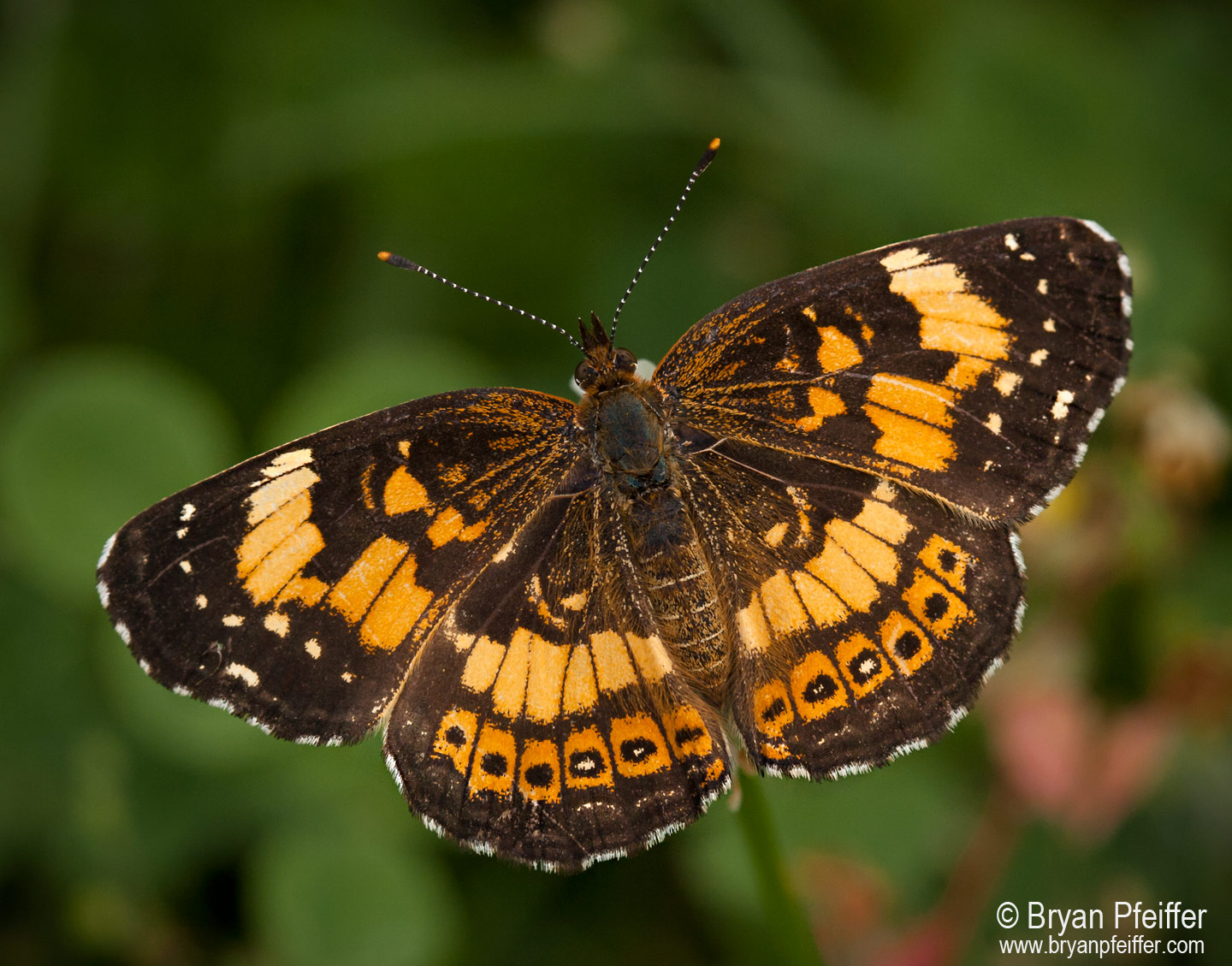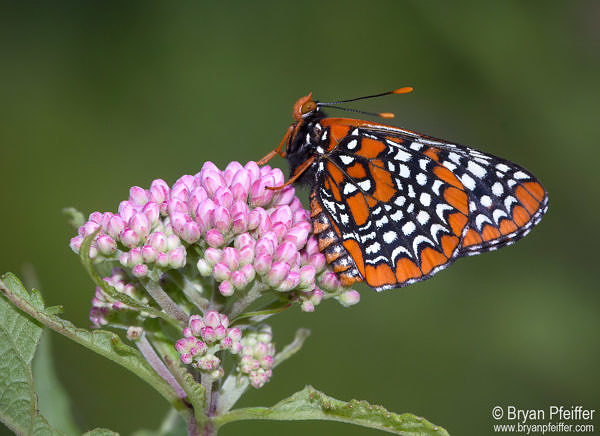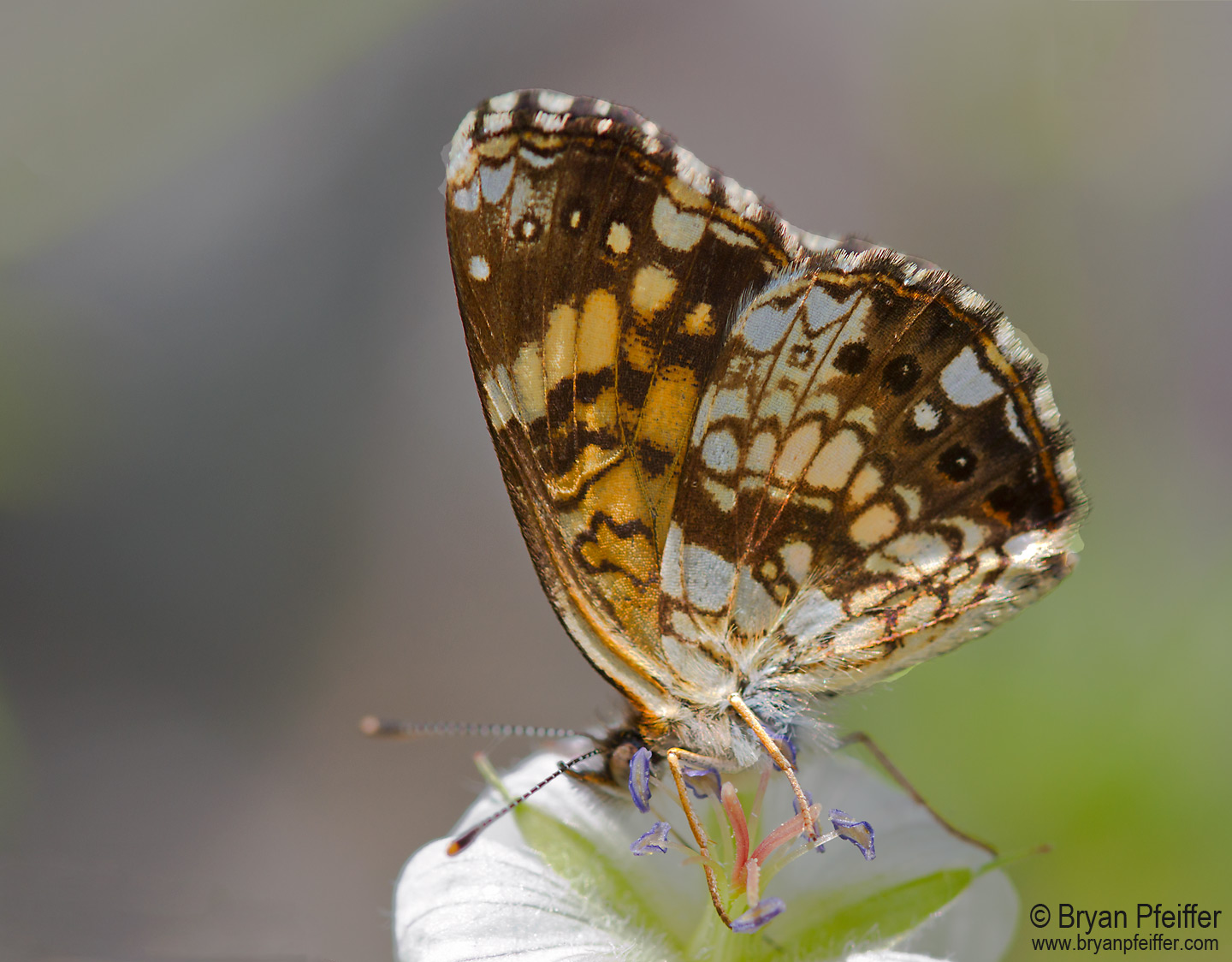The Sunflower and the Butterfly: Together They Fall

Silvery Checkerspot (Chlosyne nycteis) / © Bryan Pfeiffer
WHEN VERMONT GAS SYSTEMS cut and trampled Harsh Sunflowers along its pipeline route in Monkton this summer, the company did more than destroy some rare plants: it could have killed an imperiled butterfly.
As an entomologist who chases butterflies around the world, when I see a Harsh Sunflower I see more than audacious leaves and an explosive yellow bloom. I also see Silvery Checkerspot — one of the rarest butterflies in Vermont.
Plants are never merely plants. In the grand diversity of life, plants offer us medicines and backyard ornaments. They protect us from floodwaters and give us oxygen to breath. And plants are food — for us and for wildlife. The sunflower and the checkerspot — they go together.
Silvery Checkerspots lay their eggs on Harsh Sunflowers and its relatives. From those eggs, the butterfly’s caterpillars hatch and munch on sunflower leaves — and sometimes on no other plant. So if you kill the host, you may easily kill the caterpillar. (Think how far you’d get eating dead and withered lettuce or vegetables with no alternatives.)

Baltimore Checkerspot (Euphydryas phaeton) / © Bryan Pfeiffer
With a wingspan no greater than two inches, Silvery Checkerspot is a mile of summer joy. It flaps and glides and dances among our wildflowers with dreamy gossamer elegance. Named for their tartan black, orange and white markings, checkerspots are some of the most shocking and beautiful butterflies on the continent. You want audacity on the wing? Find it among checkerspots, like this Baltimore Checkerspot I photographed on Joe-Pye Weed in East Montpelier last month.
For nearly two decades, I’ve studied butterflies in every corner of our state, including serving as lead field lepidopterist for the Vermont Butterfly Survey (a project of the Vermont Center for Ecostudies). Among literally thousands of encounters with nearly all of Vermont’s 110 or so butterfly species, only once have I found Silvery Checkerspot — in Charlotte, on June 25, 2005, not far from the Vermont Gas Systems pipeline route. Silvery Checkerspot, among Vermont’s rarest of butterflies, needs its sunflowers standing tall.
I can’t say for certain that Vermont Gas Systems killed Silvery Checkerspots along with those sunflowers. It appears that nobody checked the sunflowers for a population of checkerspots along the pipeline route. We tend to be plant- and vertebrate (particularly bird)-centric in our protection of rare and endangered species. And Vermont Gas Systems didn’t destroy the entire patch of the sunflowers, so odds are good that if the butterfly was there, it’s still there. Silvery Checkerspots, more common to our south, can also get by on some of the sunflower’s more common relatives — but only if they’re around. In any event, we need to look for Silvery Checkerspots among those Harsh Sunflowers in Monkton — either now or next summer.
And all of us must look at plants as more than plants. Plants are food for wildlife we love and protect. You want Monarchs in your garden? Plant the Monarch’s food: milkweeds. You want birds in your yard, grow an oak. Birds don’t eat oak leaves, but feeding on those leaves will plenty of bird food: countless moth caterpillars and other insects. Oaks set a far better table for birds than maples.
Plants and insects share a evolutionary history of mutual exploitation and mutual benefit. Butterflies are among the animals that let a thousand flowers bloom. So whenever we consider plants, let us also regard — and protect — the animals that help drive the evolution of nothing less than raw diversity and beauty on Earth: insects.

The underside of a Silvery Checkerspot (Chlosyne nycteis) / © Bryan Pfeiffer

There is a caterpillar eating my teddy sunflower the whole thing I am so mad I want to kill it but haven’t decided yet.
What in particular does a sunflower gain from butterflies? I’m a copywriter and has a job to describe a painting.. for weeks now I’ve not seen a clear blog or a research that has mentioned anything in particular that sunflowers gain from Butterflies.
I think they rather share a blue relationship that only benefits the Butterflies.
Caterpillars feed on young buds and cause them sickness and death rather than bliss, and the most pollinator of sunflower is sun bees, or rather self pollination.
Please point me aright as I really need help on this subject of sunflower gains
Dear Bryan – I took a photo of a butterfly in my wildflower meadow a few weeks ago. I believe it is a Silvery Checkerspot, resting and feeding on Rudbeckia. That led me back to this blog. While I usually read your blogs, I’d missed this one. Thanks as always for your wisdom and observations. Kay in Hinesburg
bryan, i’m pretty i saw one of these guys up here on upper road in plainfield this summer. we used to have them every summer back in rural west virginia, when i was a tadpole (now, i’m a full grown frog)
Thanks, Sue. Good to hear that others are concerned! I’ve only seen 2 instances of Primrose Moths, this season, in my part of New York (near Albany), but, in 2 trips to Maine, I’ve seen them, each time. In this hot, dry season, it seems the plants are doing better in Maine.
The highway crews seem to be cutting along the roads, regularly, even in rural areas. I can’t think of any good reason for it, unless they are trying to look busy.
Thanks, Sandra. I miss the Iowa tall-grass prairies and their wildflowers and butterflies!
I once noticed that a major weed-whacking job at a park in Michigan had cut everything … except the Purple Loosestrife, which was in flower. Ugh!
Hi Rita,
Don’t give up hope. We can make progress! 🙂
Best,
Bryan
Thanks, Sue. I’ve been looking at Evening Primroses — no luck so far this year.
I leave Evening Primrose in our yard in hopes of the moth that has yet to take up residence here. I enjoy the diversity that native plants bring to our property. B. Bowen Carr, I agree with you. I enjoy inventorying the moths on our property, along with other life forms!
Thank you for speaking out about this and putting some perspective on what we humans are actually doing in our slow creep towards destruction.
This is the same concern I have about the Primrose Moth, whose host plant is the Evening Primrose. Evening Primrose is a tall, gawky plant & is, frequently, cut down, reducing habitat for the moth. I’ve been following the moths since 2008. It seems, each year, that I see fewer. Drives me crazy!
Well done, Bryan. Thank you.
Thank you Bryan. Another very interesting piece on butterfly’s and plants with photos that are so pretty. I so enjoy getting your blogs here in DesMoines, IA. I pass them on to other people I think will get a kick out of reading your comments. Look forward to more of them.